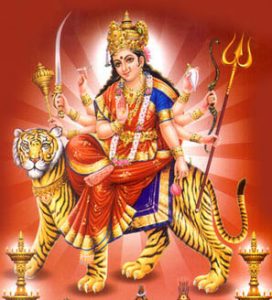| Navaratri |
 Navratri comprises of fun-filled days of the enchanting dandia beats and garba dance. The events bring in hopes- brightly lit nights, women dressed in ghagra cholis and people swirling in dandiya.
Navratri comprises of fun-filled days of the enchanting dandia beats and garba dance. The events bring in hopes- brightly lit nights, women dressed in ghagra cholis and people swirling in dandiya.
The festival of Dussera, also known as Vijayadashmi, is a captivating festival celebrated by Indians across the globe with paramount enthusiasm. The celebration lasts for ten incessant days, the first nine nights are spent in the worship of goddess Durga and the tenth day of Dussera is in the honour of Durga Devi. The month passes by with continuous joy and get-togethers. The festival is celebrated as an adornment of God as Mother. Traditionally Navaratri is a period of purifying the inner self and an auspicious time for starting new ventures. During this period, Durga, Lakshmi and Saraswati are worshipped as three different manifestations of Shakti (Cosmic energy).
THE BELIEF RELATED TO DURGA POOJA AND DUSSERA
The downfall of ‘Mahishasura’- the demon king.
Long ago, there was a demon called Mahisasura. After prolonged meditation, he earned the favour of ‘Lord Shiva. Pleased with his devotion, Shiva blessed him with the boon of immortality. As a result, Mahishasura started his reign of terror over the world. Innocent people were mercilessly killed and with the passage of time, he turned malicious.
In the heaven, the Gods went to Lord Shiva for help and told him about the atrocities caused by the demon. Lord Shiva, annoyed hearing about the chaos, used his third eye, which is believed to be the most powerful outlet of his anger.
Lord Shiva determined to create a woman and Goddess Durga, the eternal mother, was born. Riding on a lion, she transformed into the most ferocious form of the Goddess, Devi Chandika and attacked Mahishasura in the fierce battle and beheaded him. This marks the end of the evil. And Goodness prevailed ever after.
